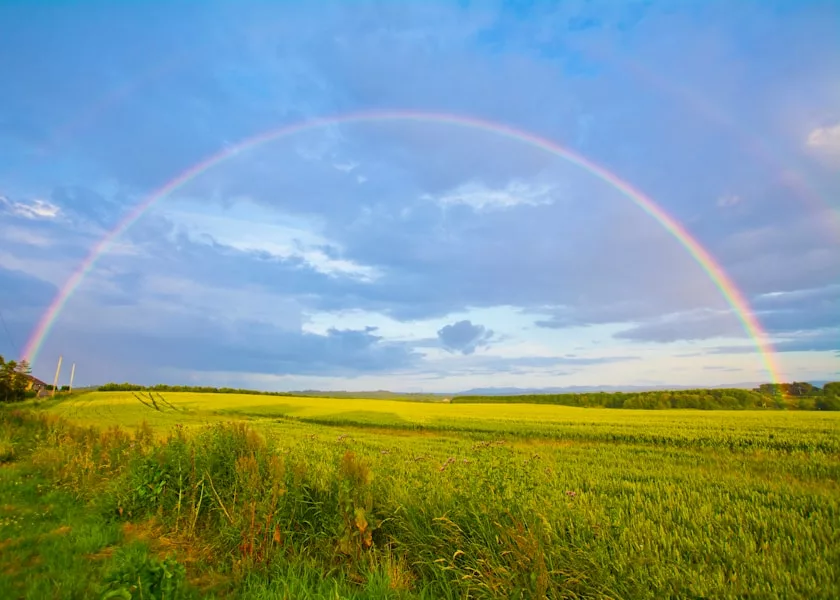A rainbow is a meteorological phenomenon that is caused by reflection, refraction and dispersion of light in water droplets resulting in a spectrum of light appearing in the sky. It takes the form of a multicolored circular arc. Rainbows are a symbol of hope, childhood joy, and the beauty of nature. But throughout history and across cultures, rainbows have held much deeper spiritual significance. Rainbows represent deities, omens, bridges between worlds, and blessings.
Brief Scientific Explanation of Rainbow Formation
Before diving into the mystical meanings, let’s briefly look at how rainbows are formed scientifically. Rainbows are optical illusions that occur when sunlight interacts with water droplets in the atmosphere. Sunlight is made up of the full spectrum of visible light wavelengths, from violet to red. As sunlight enters a water droplet, some light is reflected off the back of the droplet while the rest is refracted (bent). Different wavelengths bend at slightly different angles, causing them to separate and reflect back out of the droplet as the rainbow spectrum we see.
The most vivid rainbows form when the sun is lower in the sky, at an angle of 40-42 degrees relative to the observer. The raindrops also need to be within a certain, optimal distance for the full color spectrum to shine through. A rainbow’s arc shape stems from the fact that different colors bend at slightly varying angles. Red light in the rainbow spectrum bends the least while violet bends the most.
Now that we understand the optics behind rainbows, let’s explore the many symbolic meanings they have held across human cultures and mythologies.
Rainbows Represent Hope and Joy After Gloom
In modern society, rainbows are commonly associated with happiness, hope, and innocence. The sight of a rainbow is uplifting, especially right after gloomy weather. The vibrant spectrum sparks optimism and childlike joy.
Rainbows only appear when the sun emerges after a storm. The juxtaposition reminds us that even the darkest times will pass. Just as rainbows shine through the dispersing raindrops, we can find light and hope in the wake of hardship.
“My mom told me to always look for rainbows after a storm. She was right, rainbows are beautiful signs that the storm is over and sun is coming out again!”
The fleeting nature of rainbows also evokes a sense of cherishing the present. Like a rainbow, moments of peace and inspiration often fade quickly. Rainbows remind us to appreciate these special moments before they pass.
In many cultures, rainbows also represent the innocence and wonder of childhood. Children have not yet lost their ability to find joy and magic in ordinary things like rainbows. For adults overwhelmed by life’s stresses, the sight of a rainbow returns them to that youthful outlook for a moment.
Rainbows as Connectors Between Realms
In various myths around the world, rainbows serve as bridges, connectors, or pathways between different realms of the cosmos.
Linking Earthly Realm and Divine Realms
According to Norse mythology, the rainbow bridge Bifrost connects Midgard (the realm of humans) with Asgard (the realm of the gods). It stretches from a sacred well on earth all the way to the door of Valhalla, the Norse afterlife. Only the gods were permitted to use Bifrost as their passageway.
In Chinese mythology, the goddess Nuwa created humans and repaired the pillar holding up the sky. As a reward, the Jade Emperor created the Rainbow Bridge to link Nuwa’s earthly home to the heavens. This allowed deities to freely descend to earth and Nuwa to ascend to the divine realm.
The Japanese believed rainbows were bridges allowing their sun goddess Amaterasu to descend from the heavens and spirits to ascend from the earth. Some Asian cultures also saw the rainbow as a separator between the spiritual upper waters and lower mundane waters.
Pathways to the Afterlife
Since rainbows seemed to touch down on earth while stretching up into the sky, many cultures believed they could guide souls to the afterlife.
In Norse myths, gods traversed the rainbow bridge Bifrost to reach Valhalla, their majestic hall in the heavens where warriors’ spirits lived on. Bifrost served as a celestial gateway for fallen heroes to enter the afterlife.
Some Native American tribes considered rainbows pathways for communication between living shamans and the deceased. The Lakota people believed rainbows connected this world with the spirit world.
Rainbows also feature in some religions’ conceptions of the afterlife. In Christianity, rainbows represent God’s promise and sign of hope. After the Great Flood, the rainbow sealed God’s covenant to never again destroy the earth. It’s seen as a celestial passageway symbolizing that believers can enter Heaven after death.
Rainbows Symbolize Deities and Their Gifts
Since ancient times, rainbows have been associated with various powerful gods and goddesses of nature, weather, and fertility.
In Greek mythology, Iris is the goddess of the rainbow and a messenger linking the gods to humanity. She travels on rainbows down to earth to deliver divine missives. Iris has power over sea and sky. She fills the clouds with water from the oceans to provide rain and snow.
Nuwa is the Chinese goddess who created humans and repaired the pillar of heaven. Her gifts of the Rainbow Bridge allowed communication between earth and the heavens. Nuwa represents feminine virtues like compassion, moderation, and meditation.
The Maya goddess Ixchel is associated with rainbows, fertility, medicine, and childbirth. As a moon goddess, Ixchel’s cycles of fertility and infertility mirrored the moon’s phases. Maya women worshipped Ixchel for her life-giving powers.
In the Bible’s Book of Genesis, God created the rainbow as a sign of his covenant with Noah after the Great Flood. The rainbow symbolized God’s promise to never again flood the entire earth. For Judeo-Christian cultures, rainbows represent divine forgiveness, protection, and blessing.

Iris, the Greek personification of the rainbow. Iris used rainbows to travel between realms and deliver messages between gods and mortals.
Rainbows as Omens: Signs of Luck or Misfortune
Across the world, rainbows have been viewed as omens – signs of either good or bad fortune ahead.
Seeing a rainbow is considered highly auspicious in many cultures. Some Native American tribes considered rainbows around their settlements a sign of peace and goodwill from the Great Spirit.
In Irish lore, leprechauns hide pots of gold at the ends of rainbows. Finding a rainbow’s treasure brings tremendous luck. But the clever leprechauns ensure only those pure of heart can ever find their elusive gold.
For the ancient Greeks, rainbows rising from the sea were said to foretell great abundance in crops and livestock fertility. Farmers eagerly anticipated these fortuitous rainbows.
In traditional Chinese wisdom, a rainbow heralds harmony at home and smooth-sailing ahead. Couples who see a rainbow together can look forward to lasting marital bliss.
Many cultures associate rainbows with pregnancy and childbirth. In Burmese folklore, a pregnant woman who dreams of a rainbow will deliver a healthy son. Celtic legends say that babies conceived under a rainbow will lead especially charmed lives.
However, rainbows can also be harbingers of misfortune in some myths. In Burmese Buddhism, the demon Mareechi takes the form of a rainbow to devour children. Parents traditionally call their children inside when a rainbow appears.
The Karen people of Myanmar and Thailand view all rainbows as malevolent demons. They believe rainbows consume sunlight and drink rainwater, causing droughts or floods.
Rainbow Meanings Today: LGBTQ Pride and COVID Hope
In contemporary society, rainbows have taken on new but related meanings – as symbols of diversity, hope, and light during dark times.
Rainbow Flags as Symbols of LGBTQ Pride
Today, rainbow flags and rainbows represent LGBTQ pride, equality, and diversity. The rainbow pride flag was popularized as a symbol for gay rights in the late 1970s by artist Gilbert Baker. It represents the diversity of genders and sexualities within the queer community. Each color of the rainbow symbolizes a different aspect of queer identity and pride.
During gay liberation marches and parades, rainbow flags proudly proclaim the vibrancy, resilience, and solidarity of LGBTQ people. June is celebrated as Pride Month with rainbow-themed events and parades. For the LGBTQ community, rainbows celebrate their diversity and represent hope for a future of equality.
Signs of Optimism During the COVID-19 Pandemic
When the COVID-19 pandemic gripped the world in 2020, rainbows became symbols of hope and unity. Children around the globe placed rainbow drawings in windows as messages of hope and togetherness during lockdowns. Rainbows reminded communities to stay optimistic during the crisis, knowing brighter days would come after the storm.
Healthcare workers shared photos of rainbows, keeping their spirits up during grueling hospital shifts. Clouds with rainbows offered moments of respite and inspiration. The rainbows conveyed “we’re all in this together” and “love will get us through.”
Just as rainbows represent childhood joy and innocence, they signaled a return to simpler sources of happiness during an overwhelming time. Their vibrant colors uplifted worried hearts.
Personal Meaning When You See a Rainbow
So what might seeing a rainbow mean for you and your own life journey? Rainbow sightings can be very personally significant if you pause to reflect.
Reflect on Ongoing Issues or Questions
When you see a rainbow, take it as a sign to reflect deeply on any persistent issues or questions weighing on you. Let the rainbow’s light inspire you. Hidden solutions to challenges often arise when you create mental space for reflection. A rainbow reassures you that answers exist, even if temporarily obscured.
Hope and Peace Are Coming Your Way
When periods of darkness or storms arise in your life, rainbows signal better times ahead. The presence of a rainbow means your current troubles will pass and clarity will emerge, just as the sun always shines again after rain. A rainbow brings reassurance that you have the inner strength to weather difficult phases. Take heart knowing peace and hope are around the corner.
Luck and New Beginnings Await You
Rainbow sightings may herald fortuitous events entering your life, just like the mythical pots of gold they lead to. Keep an eye out for lucky opportunities after seeing a rainbow. It may also signify that you’re entering a new phase or chapter, with exciting potential for growth. Let the rainbow mark the beginning of something fresh and revitalizing.
Conclusion: Rainbows Universally Symbolize Blessings and Hope
Across vastly different cultures worldwide, rainbows share common symbolic meanings of promise, hope, and inspiration. Rainbows embody the themes of emerging light after darkness, bridging divides, divine blessings, innocence regained, and good fortune.
Next time you’re lucky enough to spot a rainbow’s radiant arc, take a moment to reflect on its significance. Let its beauty rekindle your sense of wonder and hope. Know that its vibrant colors convey uplifting messages, no matter your background. Rainbows universally speak to the human spirit, reminding us: Dark storms always pass, joy and light ever return, luck awaits, and there are always bridges to brighter shores ahead. We need only seek the rainbows to find them.



